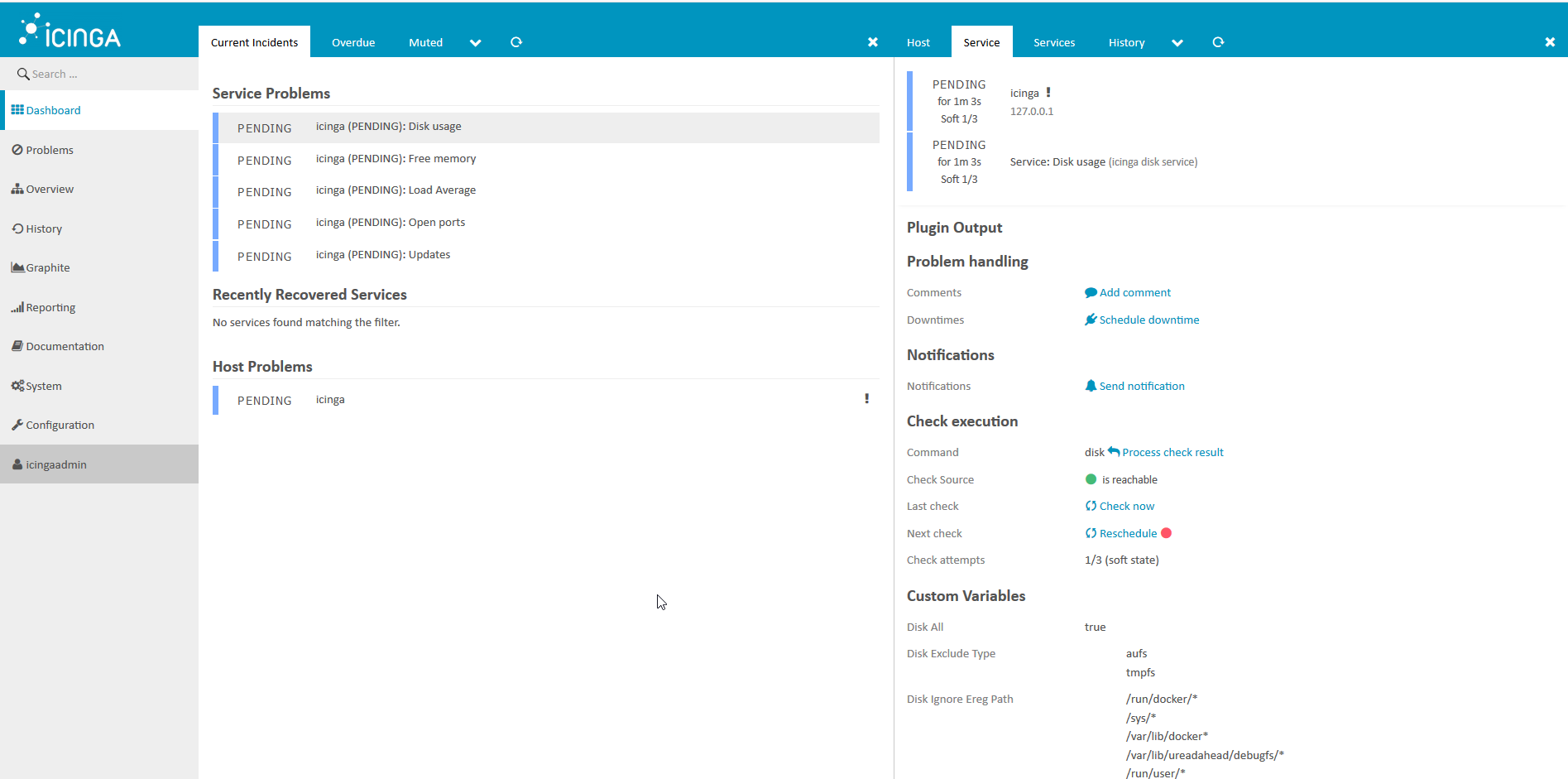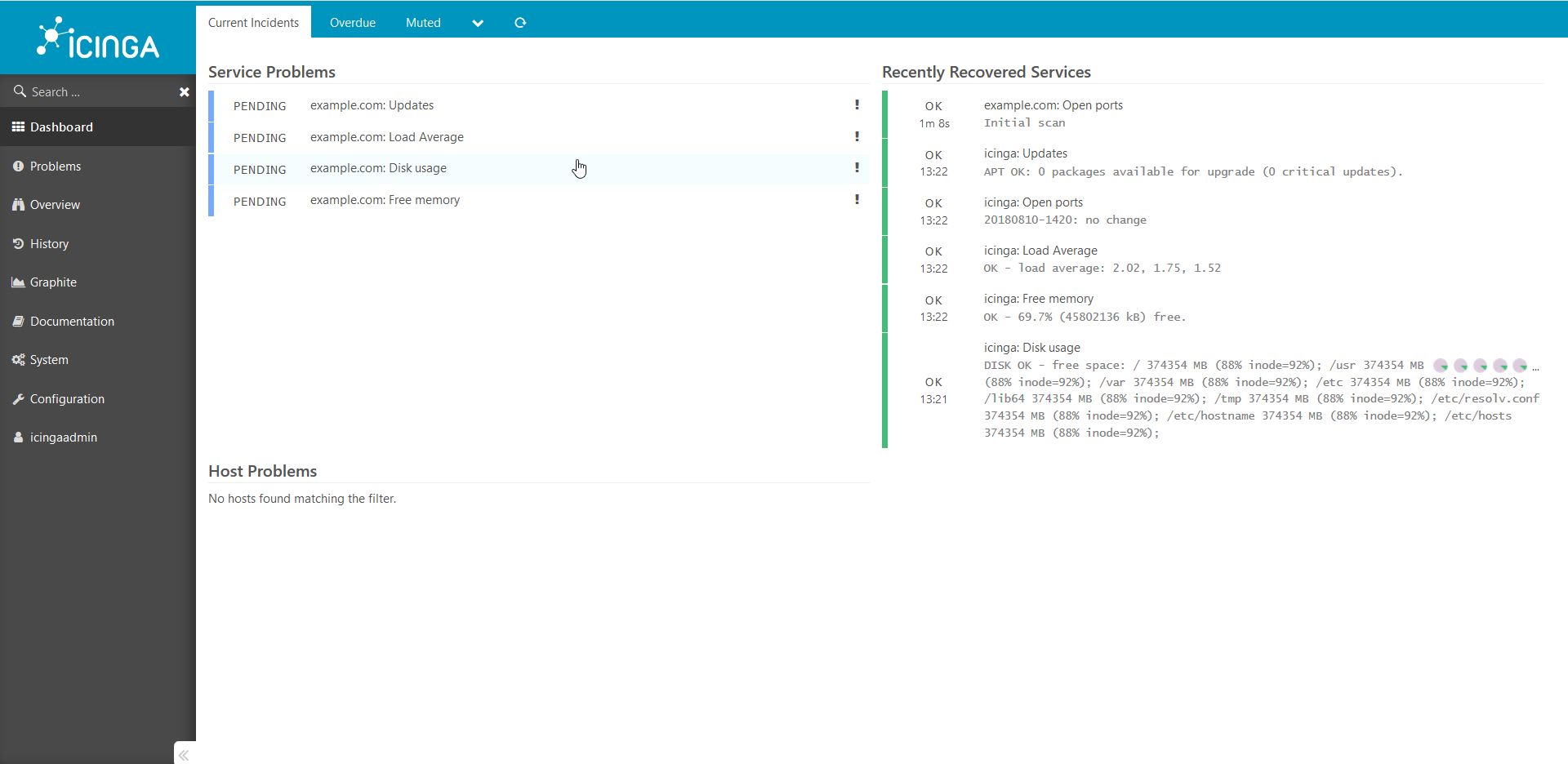 Automação de um sistema de monitoramento baseado em Icinga2 e Puppet
Automação de um sistema de monitoramento baseado em Icinga2 e Puppet
Vamos falar um pouco sobre ... Infraestrutura como código (IaC).
No Habré, existem alguns artigos muito bons sobre o Icinga2, também existem excelentes artigos sobre o Puppet:
Icinga2 é uma opção fácilElevamos o micromonitoramento no icinga2 com as despesas mínimasConfigurando um servidor Puppet moderno a partir do zeroNo entanto, o tópico de automação e integração desses dois sistemas incríveis não é divulgado.
Neste guia, mostrarei em um exemplo "vivo" como você pode combinar essas duas
sistemas, obtenha uma ferramenta poderosa para monitorar sua infraestrutura com todas as funções necessárias. Este artigo é um tipo de guia de ação para instalar o pacote "tudo em um frasco". Depois de concluir este guia, você terá uma solução de monitoramento totalmente operacional disponível, que poderá ser “finalizada” por conta própria. Vamos tentar!
Então:
Criamos um novo host. E precisamos:
1. Para que seu monitoramento apareça automaticamente no Icinga2, e as verificações básicas sejam criadas:
Cheques
| Instantâneos
| Explicações
|
Anfitrião
| 
| Em uma determinada frequência, verificamos com o comando ping se o host está "ativo".
|
Uso de disco
| 
| Verifique se temos espaço livre em disco suficiente. |
Carga média
| 
| Monitoramos a carga no servidor dinamicamente. O número de processadores nele é levado em consideração. |
Memória livre
| 
| Verificamos se temos memória livre suficiente no servidor. |
Portas abertas
| 
| Examinamos as portas no servidor e criamos um mapa de portas abertas. Monitoramos que não tínhamos novas portas abertas ou fechadas. |
Atualizações críticas
| 
| Monitoramos a presença de atualizações críticas no servidor. |
2. Adicione verificações personalizadas para vários serviços de maneira conveniente e compreensível. O que mostraria ao diretor como somos bons companheiros e receberia um prêmio!
Alguns exemplos:
Serviço
| Código de verificação YAML
|
|---|
Host virtualVerifique o host "ao vivo" ou não.

| '%{::fqdn} virtual host' : target: /etc/icinga2/zones.d/master/%{::fqdn}.conf apply: true assign: [ 'host.name == %{::fqdn}' ] display_name: '%{::fqdn} virtualhost' check_command: 'http' vars: http_uri: / http_ssl: true http_vhost: 'hostname' http_address: "%{lookup('host_address')}"
|
PostgreSQLVerifique se podemos conectar ao banco de dados PostgreSQL.

| '%{::fqdn} PostgreSQL': target: /etc/icinga2/zones.d/master/%{::fqdn}.conf apply: true assign: [ 'host.name == %{::fqdn}' ] display_name: 'PostgreSQL' command_endpoint: '%{::fqdn}' check_command: "postgres" vars: postgres_host: "localhost" postgres_action: "connection" phone_notifications: true
|
Status NginxMonitoramos o status do Nginx por meio de stub_status.

| '%{::fqdn} nginx status' : target: /etc/icinga2/zones.d/master/%{::fqdn}.conf apply: true assign: [ 'host.name == %{::fqdn}' ] command_endpoint: '%{::fqdn}' display_name: 'nginx status' check_command: 'nginx_status' vars: nginx_status_host_address: localhost nginx_status_servername: server.com nginx_status_critical: '1600,60,30' nginx_status_warn: '1500,55,25'
|
3. Que tudo estava arrumado, confiável e bonito. E o mais importante, não gaste mais de 30 minutos mexendo na configuração inicial.
Você deve ter experiência com o Docker e, portanto, com o Linux - por si só.
Esta configuração é descrita em Debian / Ubuntu. E, embora eu não veja nenhuma razão para ele não trabalhar em outros sistemas semelhantes ao Unix, eu próprio não posso dar tais garantias. Eu tenho algumas máquinas com o CentOS, ele funciona lá, mas a maioria, no entanto, é Debian / Ubuntu.
Vamos começar
Eu direi imediatamente, é conveniente para mim quando toda a configuração do host é serviços, configurações, software, contas etc. - eles são descritos por um arquivo yaml, isso evita a documentação da infraestrutura e fornece uma configuração clara. Ele abriu o projeto correspondente no repositório git, onde os nomes dos arquivos correspondem ao nome do host, depois abriu a configuração do host desejado. E você pode ver imediatamente quais serviços estão no host, o que é feito backup disso, o que é monitorado etc.
É assim que a estrutura do projeto no repositório se parece: project_1/hostname1.com.yaml project_2/hostname2.com.yaml project_3/hostname3.com.yaml
Eu uso aqui esse modelo, que descreve a configuração de qualquer um de nossos servidores:
Modelo completo #============================|INPUT DATA|=================================# #---------------------------------------|VARS|----------------------------# #---//Information about variables, keys & contacts//----------------------# host_address: xxxx my_company: my_mail_domain: my_ssh_port: #---------------------------------------|CLASSES|-------------------------# #---//Classes are modules installed on the server.//----------------------# #---//These modules process the arguments typed below.//------------------# #---//Without classes nothing will work.//--------------------------------# #---//Class default_role is mandatory. This class will install//----------# #---//etckeeper, some required perl modules and manages all the logics.//-# classes: - default_role #---------------------------------------|TIMEZONE|------------------------# #---//Set timezone, which will be used on the host.//---------------------# timezone::timezone: Europe/Moscow #---------------------------------------|FACTS|---------------------------# #---//Facts are variables which puppet agent uses.//----------------------# facter::facts_hash: role: value: 'name' company: value: 'name of company' file: 'location.txt' #=========================================================================# #============================|PUPPET|=====================================# #---//Settings for puppet agent.//----------------------------------------# puppet::runmode: cron puppet::ca_server: puppet::puppetmaster: #=========================================================================# #============================|CRON TASKS|=================================# cron_tasks: Name: command: user: minute: '' hour: '' #=========================================================================# #============================|SUPERVISOR|=================================# #---//Supervisor is a process manager//-----------------------------------# supervisord::install_pip: false supervisord::install_init: false supervisord::service_name: supervisor supervisord::package_provider: apt supervisord::executable: /usr/bin/supervisord supervisord::executable_ctl: /usr/bin/supervisorctl supervisord::config_file: /etc/supervisor/supervisord.conf supervisord::programs: 'name': ensure: present command: 'su - rails -c "/home/name/s2"' autostart: no autorestart: 'false' directory: /home/name/domainName/current #=========================================================================# #============================|SECURITY|===================================# #-------------------------------------|FIREWALL|--------------------------# #---//Iptables rules//----------------------------------------------------# firewall: 096 Allow inbound SSH: dport: proto: tcp action: accept #-------------------------------------|FAIL2BAN|--------------------------# #-------------------------------------|ACCESS|----------------------------# #--------------------------------------------|ACCOUNTS|-------------------# #---//Discription of accounts which will be created on server.//----------# accounts: user: shell: '/bin/bash' password: '' locked: false purge_sshkeys: true groups: - docker sshkeys: - #--------------------------------------------|SUDO|-----------------------# #---//Appointment permissions for users.//--------------------------------# sudo::config_file_replace: false sudo::configs: user: content: #--------------------------------------------|SSH|------------------------# #--------//Settings for ssh server.//-------------------------------------# ssh::storeconfigs_enabled: true ssh::server_options: Protocol: '2' Port: PasswordAuthentication: 'yes' PermitRootLogin: 'without-password' SyslogFacility: 'AUTHPRIV' UsePAM: 'yes' X11Forwarding: 'no' #--------------------------------------------|VPN|------------------------# #---//Settings for vpn server.//------------------------------------------# openvpn::servers: 'namehost': country: '' province: '' city: '' organization: '' email: '' server: 'xxxx 255.255.255.0' dev: tun local: openvpn::client_defaults: server: 'namehost' openvpn::clients: # Firstname Lastname 'user': {} openvpn::client_specific_configs: 'user': server: 'namehost' redirect_gateway: true route: - xxxx 255.255.255.255 #=========================================================================# #============================|OPERATING SYSTEM|===========================# #---------------------------------------------|SYSCTL|--------------------# #---//set sysctl parameters//---------------------------------------------# sysctl::base::values: fs.file-max: value: '2097152000' net.netfilter.nf_conntrack_max: value: '1048576' net.nf_conntrack_max: value: '1048576' net.ipv6.conf.all.disable_ipv6: value: '1' vm.oom_kill_allocating_task: value: '1' net.ipv4.ip_forward: value: '0' net.ipv4.tcp_keepalive_time: value: '3' net.ipv4.tcp_keepalive_intvl: value: '60' net.ipv4.tcp_keepalive_probes: value: '9' #---------------------------------------------|RCS|-----------------------# #---//Managment of RC scenario//------------------------------------------# rcs::tmptime: '-1' #---------------------------------------------|WEB SERVERS|---------------# #---------------------------------------------------------|HAPROXY|-------# #---//HAProxy is software that provides a high availability load//--------# #---//balancer and proxy server for TCP and HTTP-based applications//-----# #---// that spreads requests across multiple servers.//-------------------# haproxy::merge_options: true haproxy::defaults_options: log: global maxconn: 20000 option: [ 'tcplog', 'redispatch', 'dontlognull' ] retries: 3 stats: enable timeout: [ 'http-request 10s', 'queue 1m', 'check 10s', 'connect 300000000ms', 'client 300000000ms', 'server 300000000ms' ] haproxy_server: stats: ipaddress: ports: '9090' options: mode: 'http' stats: [ 'uri /', 'auth puppet:123123123' ] postgres: collect_exported: false ipaddress: '0.0.0.0' ports: '5432' options: option: - tcplog balance: roundrobin haproxy_balancemember: hostname1: listening_service: postgres server_names: hostname1 ipaddresses: ports: 6432 options: check hostname2: listening_service: postgres server_names: hostname2 ipaddresses: ports: 6432 options: - check - backup #---------------------------------------------|NGINX|---------------------# #---//Nginx is a web server which can also be used as a reverse proxy,//--# #---//load balancer, mail proxy and HTTP cache//--------------------------# nginx::nginx_cfg_prepend: 'load_module': - modules/ngx_http_geoip_module.so nginx::http_raw_append: - 'real_ip_header X-Forwarded-For;' - 'geoip_country /usr/share/GeoIP/GeoIP.dat;' - 'set_real_ip_from 0.0.0.0/0;' nginx::worker_rlimit_nofile: 16384 nginx::confd: true nginx::server_purrge: true nginx::server::maintenance: true #---------------------------------------------nginx-|MAPS|----------------# nginx::string_mappings: allowed_country: ensure: present string: '$geoip_country_code' mappings: - key: 'default' value: 'yes' - key: 'US' value: 'no' #---------------------------------------------nginx-|UPSTREAMS|-----------# nginx::nginx_upstreams: : ensure: present members: - #---------------------------------------------nginx-|VHOSTS|--------------# nginx::nginx_servers: 'hostname': proxy: 'http://' location_raw_append: - 'if ($allowed_country = no) {return 403;}' try_files: - '' - /index.html - =404 ssl: true ssl_cert: ssl_key: ssl_trusted_cert: ssl_redirect: false ssl_port: 443 error_pages: '403': /usa-restrict.html #---------------------------------------------nginx-|HTTPAUTH|------------# httpauth: 'admin': file: password: '' realm: realm mechanism: basic ensure: present #---------------------------------------------nginx-|LOCATIONS|-----------# nginx::nginx_locations: 'domain1.com/usa-restricted': location: /usa-restrict.html www_root: /home/clientName1/clientName1-client-release/current/dist server: domain1.com ssl: true '^~ domain2.com/resources/upload/': location: '^~ /resources/upload/' server: domain2.com location_alias: '/home/clientName2/upload/' raw_append: - 'if ($allowed_country = no) {return 403;}' '/nginx_status-domain3.com': location: /nginx_status stub_status: on raw_append: - access_log off; - allow 127.0.0.1; - deny all; #---------------------------------------------nginx-|WELL-KNOWN|----------# #---//These locations are needed for SSL certificates generating//--------# #---//with Letsencrypt.//-------------------------------------------------# 'x.hostname.zz/.well-known': location: '/.well-known' server: x.hostname.zz proxy: 'http://kibana' auth_basic: auth_basic_user_file: add_header Pragma public;public, must-revalidate, proxy-revalidate/home/hostname/hostname-release/shared/ecosystem.config.jslogslog_typeformat%{::domain}%{lookup('host_address')}/32(rw,fsid=root,insecure,no_subtree_check,async,no_root_squash)host_addresso=Debian,n=${distro_codename}o=Debian,n=${distro_codename}-securityo=Debian,n=${distro_codename}-updateso=Debian,n=${distro_codename}-proposedo=Debian,n=${distro_codename}-backportso=debian icinga,n=icinga-${distro_codename}o=Zabbix,n=${distro_codename}%{lookup('my_ftp_hostname')}%{lookup('my_backup_ftp_username')}%{lookup('my_backup_ftp_password')}%{lookup('my_backup_compressor')}/tmp/mediastagetv_netbynet%{lookup('host_address')}:/%{lookup('host_address')}redis%{lookup('host_address')}*.*;auth,authpriv.none /var/log/syslog\nmail.* -/var/log/mail.log\n& stopauth,authpriv.* /var/log/auth\n& stop:programname,contains,\ /var/log/puppetlabs/puppet/puppet-agent.log\n& stop:msg,contains,\ /var/log/iptables/iptables.log\n& stop:msg,regex,\ /var/log/admin/auth.log\n& stop:msg,regex,\ /var/log/admin/auth.log\n& stop #---------------------------------------------|LOGWATCH|------------------# #---//Logwatch is a log-analysator for create short reports.//------------# logwatch::format: text logwatch::service: # Ignore this servie - -http - -iptables #---------------------------------------------|LOGROTATE|-----------------# #---//Management of rotation of log files.//------------------------------# my_rclogs_path: '/home/hostname/hostname/shared/log' my_rclogs_amazon_path: '/home/hostname1/hostname1/shared/log_amazon' my_ttlogs_path: '/home/hostname2/hostname2/shared/log' my_ttlogs_amazon_path: '/home/hostname/hostname/shared/log_amazon' logrotate::ensure: latest logrotate::config: dateext: true compress: true logrotate::rules: booking-logs: path: '%{lookup("my_rclogs_path")}/booking_com.log' size: 2500M rotate: 20 copytruncate: true delaycompress: true dateext: true dateformat: -%Y%m%d-%s compress: true postrotate: mv %{lookup('my_rclogs_path')}/booking_com.log*.gz %{lookup('my_rclogs_amazon_path')}/ #---------------------------------------------|ATOP|----------------------# #---//ATOP service displays a new information about CPU//-----------------# #---//and memory utilization.//-------------------------------------------# atop::service: true atop::interval: 30 #----------------------------------------|DNS|----------------------------# #---//Management of file /etc/resolv.conf//-------------------------------# resolv_conf::nameservers: - 0.0.0.0 - 0.0.0.0 #=========================================================================# #============================|DATABASES|==================================# #--------------------------------------|MYSQL|----------------------------# #---//MySQL is a relational database management system.//-----------------# mysql::server::package_ensure: 'installed' #· mysql::server::root_password: mysql::server::manage_config_file: true mysql::server::service_name: 'mysql' # required for puppet module mysql::server::override_options: 'mysqld': 'bind-address': '*' : , : , : , mysql::server::db: : user: password: host: grant: - #-------------------------------------|ELASTICSEARCH|---------------------# #---//Elasticsearch is a search engine based on Lucene.//-----------------# #---//It provides a distributed, multitenant-capable full-text search//---# #---//engine with an HTTP web interface and schema-free JSON documents.//-# elasticsearch::version: 5.5.1 elasticsearch::manage_repo: true elasticsearch::repo_version: 5.x elasticsearch::java_install: false elasticsearch::restart_on_change: true elasticsearch_instance: 'es-01': ensure: 'present' #-------------------------------------|REDIS|-----------------------------# #---//Redis is an in-memory database project implementing//---------------# #---//a distributed, in-memory key-value store with//---------------------# #---//optional durability.//----------------------------------------------# redis::bind: 0.0.0.0 #-------------------------------------|ZOOKEPER|--------------------------# #---//Zooker is a centralized service for distributed systems//-----------# #---//to a hierarchical key-value store, which is used to provide//-------# #---//a distributed configuration service, synchronization service,//-----# #---//and naming registry for large distributed systems.//----------------# zookeeper::init_limit: '1000' zookeeper::id: '1' zookeeper::purge_interval: '1' zookeeper::servers: - #-------------------------------------|POSTGRES|--------------------------# #---//Postgres, is an object-relational database management system//------# #---//with an emphasis on extensibility and standards compliance.//-------# #---//As a database server, its primary functions are to store data//----# #---//securely and return that data in response to requests from other//--# #---//software applications.//--------------------------------------------# postgresql::server::postgres_password: postgresql::server::ip_mask_allow_all_users: '0.0.0.0/0' postgresql::postgresql::server: ip_mask_allow_all_users: '0.0.0.0/32' postgres_db: master: user: password: confluence: user: password: postgres_config: 'max_connections': value: 300 postgres_hba: 'Allow locals without password': order: 1 description: 'locals postgres no password' type: 'host' address: '127.0.0.1/32' database: 'all' user: 'all' auth_method: 'trust' #----------------------------------------------|PGBOUNCER|----------------# #---//PgBouncer is a connection pooler for PostgreSQL//-------------------# pgbouncer::group: postgres pgbouncer::user: postgres pgbouncer::userlist: - user: password: pgbouncer::databases: - source_db: recommender host: dest_db: recommender auth_user: recommender pool_size: 200 auth_pass: - source_db: master host: dest_db: recommender auth_user: recommender pool_size: 50 auth_pass: - source_db: slave host: dest_db: recommender auth_user: recommender pool_size: 200 auth_pass: #=========================================================================# #==============================|APPLICATION SERVICES|=====================# #---------------------------------------------------|CONFLUENCE|----------# #---------------------------------------------------|JENKINS|-------------# #=========================================================================#
Seção de monitoramento de exemplo:
#============================|MONITORING|=================================# #---------------------------------------|ICINGA SERVICES|-----------------# #---//Managment of monitoring system.//-----------------------------------# icinga2_service: '%{::fqdn} virtual host' : target: /etc/icinga2/zones.d/master/%{::fqdn}.conf apply: true assign: [ 'host.name == %{::fqdn}' ] display_name: '%{::fqdn} virtualhost' check_command: 'http' vars: http_uri: / http_ssl: true http_vhost: 'hostname' http_address: '%{::fqdn} nginx status' : target: /etc/icinga2/zones.d/master/%{::fqdn}.conf apply: true assign: [ 'host.name == %{::fqdn}' ] command_endpoint: '%{::fqdn}' display_name: 'nginx status' check_command: 'nginx_status' vars: nginx_status_host_address: localhost nginx_status_servername: server.com nginx_status_critical: '1600,60,30' nginx_status_warn: '1500,55,25' '%{::fqdn} redis': target: /etc/icinga2/zones.d/master/%{::fqdn}.conf apply: true assign: [ 'host.name == %{::fqdn}' ] display_name: 'Redis' command_endpoint: '%{::fqdn}' check_command: vars: redis_hostname: localhost redis_port: 6379 redis_perfvars: '*' #=========================================================================#
O esquema geral de operação de tal esquema consiste em apenas duas ações simples:
- Começamos o fantoche no host - o host vê os cheques que pertencem a ele e os exporta para o puppetDB.
- Execute o fantoche no contêiner icinga2 - as verificações do puppetdb se transformam em configurações reais do Icinga2.
Aqui, muitos dirão:
"Por que tenho que fazer tudo isso acontecer, se posso levantar o icinga2 habitual e adicionar cheques com as mãos ou através da interface da web?"De fato, se você precisa monitorar uma dúzia de hosts com centenas de serviços e é uma pessoa razoavelmente elegante, com boa memória (não encontrada na natureza), não faz sentido cercar um jardim. É uma questão completamente diferente se você tiver uma infraestrutura bastante grande e houver a sensação de que pode ter esquecido algo em algum lugar. Nesses momentos, a automação ajuda muito, porque ajuda a colocar tudo nas prateleiras e evitar, de várias maneiras, o fator humano.
Indique as principais vantagens:
Vamos olhar para este modelo: icinga2_service: '%{::fqdn} disk service': target: /etc/icinga2/zones.d/master/%{::fqdn}.conf apply: true assign: [ 'host.name == %{::fqdn}' ] display_name: 'Disk usage' command_endpoint: '%{::fqdn}' check_command: 'disk' vars: #All disks disk_all: true disk_exclude_type: - aufs - tmpfs disk_ignore_ereg_path: - /run/docker
+ 1. Hiera — .. . Icinga2, , . , , , .
+ 2. , . — .
+ 3. , .. , Icinga2 , puppet Icinga2.
+ 4. Portanto, todas as verificações que armazenamos em um único banco de dados puppetDB, podemos criar scripts bastante poderosos para automação adicional, na qual usaremos essas informações.
Então vamos
1. Configure o boneco.
Espero que você tenha configurado o docker e o docker-compondo.Caso contrário, será necessário instalá-los:Instalando o Docker ...Instalando o Docker-compose ...2. Clonamos o repositório no nosso servidor:
git clone http://git.comgress64.com/external/puppet-icinga2-how-to.git
3. Abra o docker-compose.yaml com o seu editor favorito e veja-o.
Vemos que neste pacote temos vários containers subindo ao mesmo tempo - PuppetServer, PuppetDb, servidor PostgreSQL e PuppetBoard. Também montou volumes do diretório atual. Essa configuração não é ideal para todos, portanto, considere sua infraestrutura. Alguém já tem um servidor PostgreSQL, alguém quer armazenar código em outra seção - eis a liberdade de criatividade. Nesse estágio, sugiro deixar o modelo padrão - você sempre pode retornar a ele mais tarde. Vamos pegar nosso pacote de contêineres e ver o que aconteceu:4. Inicie o contêiner Puppet, Postgres, Puppetdb e Graphite.
Agora, carregamos várias imagens e lançamos contêineres, criamos bancos de dados no PostgreSQL. Vamos esperar até que todos os servidores sejam iniciados - os erros podem ser ignorados, porque devem estabilizar após algum tempo. Pressione Ctrl + C para sair do modo de exibição de log.5. Verifique o trabalho do nosso mestre de marionetes:
docker run --net puppeticinga2howto_default --link puppet:puppet puppet/puppet-agent
6. Se estiver tudo bem, você verá esta conclusão:
Notice: Applied catalog in 0.03 seconds Changes: Total: 1 Events: Success: 1 Total: 1 Resources: Changed: 1 Out of sync: 1 Total: 8 Time: Schedule: 0.00 File: 0.00 Transaction evaluation: 0.01 Catalog application: 0.03 Convert catalog: 0.04 Config retrieval: 0.45 Node retrieval: 1.38 Last run: 1532605377 Fact generation: 2.24 Plugin sync: 4.50 Filebucket: 0.00 Total: 8.65 Version: Config: 1532605376 Puppet: 5.5.1
Configure o servidor Icinga2.7. Crie a imagem do Dockerfile, executando:
docker-compose build icinga
8. Execute o contêiner no qual o servidor Icinga2 viverá.
docker-compose up -d icinga
9. Até agora, nosso contêiner está vazio. Vamos configurar o servidor icinga2 usando nosso servidor Puppet, fazendo:
10. Instale e configure Icinga, Icingaweb2 e Apache.
Seu servidor Icinga2 está pronto!
Icingaweb2
1. Vamos ver o que temos.
É conveniente observar o estado do sistema de monitoramento no navegador, faça:Abra no navegador http://ip___:8081/icingaweb2e vá para Icinga com o login padrão: icingaadmin / icinga .Vemos esta figura: Após alguns minutos, vemos que todas as verificações funcionaram para nós: Os
Após alguns minutos, vemos que todas as verificações funcionaram para nós: Os gráficos também funcionam:
gráficos também funcionam: Temos um ambiente de trabalho da Web para Icinga2, mas ainda não há hosts conectados a Icinga, vamos conectar nosso primeiro host.
Temos um ambiente de trabalho da Web para Icinga2, mas ainda não há hosts conectados a Icinga, vamos conectar nosso primeiro host.2. Conecte o novo host ao sistema de monitoramento
Agora, temos apenas um host conectado ao icinga2 - Icinga. Vamos conectar outro.Estou mostrando um exemplo em uma janela de encaixe, mas o mesmo funcionará com o bare metal:primeiro você precisa preparar um modelo e fornecer algumas informações sobre o host do fantoche:
. hostname , : docker run --hostname example.com --rm -t --link puppet:puppet --net puppeticinga2howto_default -i phusion/baseimage:latest /sbin/my_init -- bash -l
puppet : apt-get update && apt-get install -y ruby make gcc perl-modules && gem install --no-ri --no-rdoc puppet
puppet: puppet agent --server puppet --waitforcert 60 --test
icinga2 puppetDB. , puppet icinga2: docker-compose exec icinga puppet agent --server puppet --waitforcert 60 --test
Examinamos através do navegador o que obtivemos: as verificações foram adicionadas e aguardam conclusão.Após 5 minutos:
verificações foram adicionadas e aguardam conclusão.Após 5 minutos: Da mesma maneira, todos os outros hosts são adicionados ao sistema. Quero chamar sua atenção para o fato de que este guia é uma prova de conceito e não pode ser usado em um ambiente de produção sem nenhuma modificação.Se o artigo parecer interessante, da próxima vez mostrarei como você pode adicionar todos os tipos de verificações personalizadas interessantes, compartilhar segredos e contar sobre todos os tipos de sutilezas. Além disso, se houver um desejo, contarei mais detalhadamente como tudo isso funciona por dentro.Obrigado pela atenção!
Da mesma maneira, todos os outros hosts são adicionados ao sistema. Quero chamar sua atenção para o fato de que este guia é uma prova de conceito e não pode ser usado em um ambiente de produção sem nenhuma modificação.Se o artigo parecer interessante, da próxima vez mostrarei como você pode adicionar todos os tipos de verificações personalizadas interessantes, compartilhar segredos e contar sobre todos os tipos de sutilezas. Além disso, se houver um desejo, contarei mais detalhadamente como tudo isso funciona por dentro.Obrigado pela atenção!
Confluence:/ ./docs.comgress64.com/...:https://github.com/Icinga/puppet-icinga2https://forge.puppet.com/icinga/icingaweb2https://docs.docker.com/https://docs.puppet.com/https://docs.puppet.com/hiera/